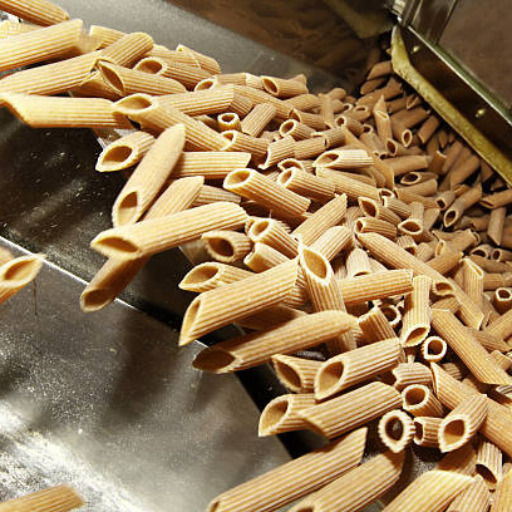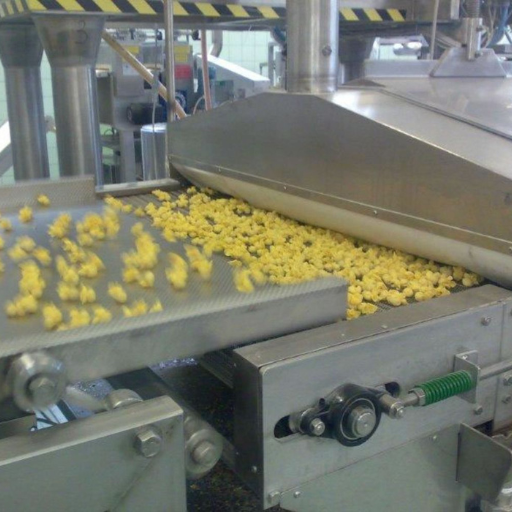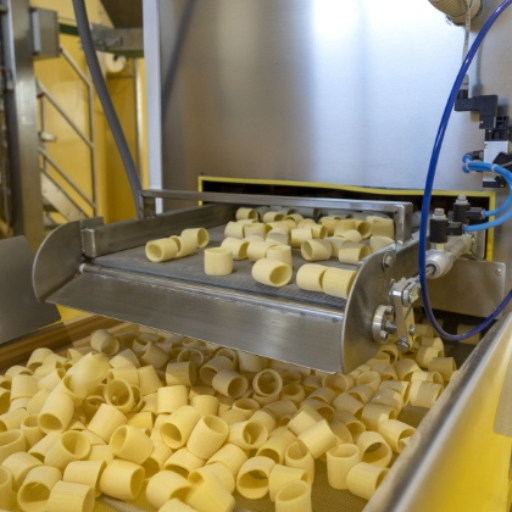Italy is renowned for its rich culinary heritage, and at the heart of this tradition lies pasta. This blog delves into the fascinating world of Italian pasta production, exploring the various aspects that make it a staple in kitchens worldwide. We will journey through the intricate processes involved in making fresh and dry pasta, and shine a spotlight on the artisanal techniques that elevate pasta making to an art form. Readers will gain insights into the historical significance, the craftsmanship, and the technological advancements that together shape the vibrant landscape of Italian pasta production. Whether you are a food enthusiast, an aspiring chef, or simply curious about the story behind your favourite pasta dish, this blog provides a comprehensive overview to satisfy your curiosity and inspire your culinary adventures.
What Are the Key Components of a pasta production line?
Different types of Pasta Machines
There are various kinds of machines involved in the production of pasta which play a crucial role in guaranteeing quality and efficiency. The fundamental equipment for pasta production include:
- Mixers: To make either fresh or dry pasta, flour is mixed with water using these devices to achieve a consistent dough.
- Extruders: Extruders are used to shape pasta by pushing it through different moulds resulting into a variety of shapes such as spaghetti, penne and fusilli.
- Sheeters and Cutters: Sheeters create thin sheets from which flat pastas like lasagna or fettuccine can be made while cutters slice it into wide strips.
- Dryers: These machines decrease the amount of moisture present in fresh pasta over time thereby giving it an extended shelf life and helping it retain its shape without spoiling.
- Pasteurizers: For making fresh pasta, pasteurisers heat up the pasta quickly enough to kill off any pathogens which may ruin the food quality.
- Packaging Machines: Once sealed hygienically, they become ready for distribution around the world’s markets.
Each piece of machinery is integral to producing high-quality pasta that meets both traditional standards and modern consumer demands.
Most Important Equipment for Pasta Production
Certain essential machines cannot miss out in any modern line manufacturing high standard pastas. These machines include among others as per some literature on the topic:
- Dough Mixers: Uniform dough used as a base for all types of pasta is produced by this machine by intimately mixing flour and water. Dough preparation phase is made more consistent with reliable high-performance mixers.
- Pasta Extruders: This type of machine is necessary for forming shapes. They produce varieties such as traditional spaghetti and penne special order or custom noodle designs by means of extruding them via delicate dies.
- Drying Machines: Drying machines are also vital since they help reduce moisture content in paste so that it has longer shelf life and maintains its texture. When drying pasta, these advanced dryers control the temperature and air flow to ensure even drying avoiding any cracks or spoilage.
These machines work in a seamless manner managing to maintain expected high standards for artisanal as well as industrial pasta making.
Choosing Appropriate Pasta Production Equipment
Efficiency and quality are the most important things when considering the right equipment for pasta production. The first thing that should be taken into account is the scale of production – whether it is artisanal small-volume manufacture of pasta or it is intended for large industrial-scale process. This will require high capacity dough mixers, reliable extruders and accurate drying machines.
Additionally, one needs to assess how flexible the equipment can be with respect to different types of shapes and recipes. Modern extruders enable manufacturers to switch from one shape to another using interchangeable dies while sophisticated analyses systems in driers provide precise control over moisture content depending on kind of pasta being dried .
Moreover, the material used in making such appliances has an impact on their durability and efficiency due to compliance with health regulations. Hygiene is ensured by stainless steel constituents employed in designing them.
At last, examine if there exist after-sales support services and maintenance packages offered by manufacturer so as not to buy a white elephant. A good technical backup ensures that your machine never breaks down unnecessarily during its lifespan thereby enabling you make good pastas nonstop all along.
How Does the automatic dry pasta production Process Work?
Knowing the production stages for pasta that is dried
For dry pasta to be produced, there are some crucial steps which have to be followed transforming raw materials into end products. The process begins with mixing and kneading in which durum wheat semolina mixed with water forms a homogenous dough. Then this dough is passed through an extruder where it is exerted via dies to assume various shapes of pasta.
After the extrusion comes the pre-drying which removes water from surface and prevents sticking. This step also prevents sticking of the product on any surfaces. Once out of the dryer, the pasta will go through cooling slowly to avoid cracking and then get processed at cutting and packing stage where it is cut into desired lengths before packing for marketing. All along this procedure it is vital to maintain accurate control over temperature and humidity for quality dry pasta production.
The role of dryers in the process
Dryers play a very important role in removing moisture gently from pasta during its drying process. This phase is very significant if good texture should be achieved on cooked paste while at the same time extending its shelf-life beyond a month. Modern dryers make use of controlled temperature and humidity settings to gradually remove water from within pasta; thereby avoiding fractures that might form during drying as well as ensuring even removal of moisture. It helps keep structural soundness and taste in place. Proper drying minimizes microbial growth by reducing water activity within the paste, hence preserving both quality & safety.
Maintaining quality in dry pasta production
To ensure that high-quality dried pasta can be consistently produced, certain critical issues must be considered:
- Ingredient Quality: Start with high-quality semolina flour that has optimal protein levels needed for desirable texture and firmness when making macaroni or spaghetti.
- Extrusion Process: Use bronze dies for extrusion to enhance sauce adherence and achieve rough textures on the pasta surface.
- Drying Techniques: Two-stage drying that has temperature and humidity as its base control units. Gradual pre-drying with controlled main drying prevents cracks and ensures uniform removal of moisture.
- Cooling and Packaging: After drying, cool down the pasta gradually to prevent thermal shocks; whereas vacuum or modified atmosphere packaging maintains product freshness and extends shelf life.
- Hygiene Practices: Maintain stringent sanitation standards throughout the production line to avoid contamination and ensure food safety.
By doing this, manufacturers maintain consistent quality in their products such as dry pasta with an optimal texture, good appearance, and longer shelf-life.
What Are the Steps in fresh pasta Production?
Importance of fresh pasta lines
Fresh pasta lines are important for making great tasting and textured pasta that is different from the dried type. Fresh ingredients, with no need for drying or preservatives, give it extra taste and make it tenderer and more elastic. They allow greater flexibility in terms of shapes and formulations as well. The reason why people love to use fresh pasta is because it takes less time to cook than dried one; therefore, it can be used in most culinary applications since it cooks faster and quickly absorbs the flavors of sauces. Finally, keeping a fresh pasta line can help cater to an increasing consumer preference towards authentic gourmet experiences.
Key elements of fresh pasta production
- Ingredient Selection: This involves the use of quality flour such as semolina or 00 flour plus fresh eggs. The texture and flavor of the final product will depend on these components’ quality.
- Mixing and Kneading: Mix flour with eggs into dough followed by kneading properly to develop gluten. If you are able to knead well, your dough should have smoothness all over which means that your dough has been well developed leading to excellent cooking properties.
- Resting the Dough: It is usually advisable for the dough to rest this helps in relaxation of gluten thus making rolling easier. A resting period imparts texture and workability to the mixture.
- Rolling and Shaping: Roll out the dough using a pasta machine or a rolling pin until you get desired thickness then cut in different shapes such as fettuccine, tagliatelle or ravioli. Uniformity in thickness allows even cooking.
- Cooking: Fresh pasta only requires a few minutes in boiling salted water before it’s ready. Only cook until al dente so that its texture and flavour are maintained when served.
Producers can thus achieve outstanding taste, texture, versatility etc by focusing on these key elements while making fresh pastas.
Integrating pasteurizers in the process
Integration of pasteurizers into fresh pasta production is a necessary step that must be taken to ensure food safety and prolong shelf life. Pasteurization involves heating the pasta at a given temperature for a certain period so as to reduce the level of harmful microorganisms while preserving its quality.
- Improved Safety: By lowering the bacterial content, including pathogens such as Salmonella or E. coli, pasteurization makes fresh pasta much safer to eat.
- Increased Shelf Life: By killing bacteria that cause spoilage, pasteurization ensures that fresh pasta can stay longer before going bad. This reduces wastage of food and allows producers to supply more efficiently.
- Maintenance of Quality: Today’s ways of pasteurizing have been made aiming at maintaining flavor and texture attributes of fresh pasta after undergoing pasteurization process which has given it its gourmet aspect even till now.
Thus by integrating pasteurizers, pasta manufacturers are able to provide products of high safety standards, quality expectations and shelf stability satisfying consumer needs for taste as well as health requirements.
How Are Different Types of special pasta Made?
Making Short-cut pasta
Proper short-cut pasta production must undergo a series of critical steps in order to achieve excellent final product. First, durum wheat semolina or flour needs to be mixed with water until a dough is formed. This dough will then be pushed through a die, shaping it into numerous types such as rigatoni, penne, or fusilli and others. Then the cutting mechanism cuts the dough into specified lengths at certain intervals which are desired. Hence after being shaped the pasta gets dried in a controlled atmosphere reducing moisture content; this helps prevent spoilage and extend shelf life. Eventually, dry pasta is packaged for sale as it still remains intact.
Preparing gluten-free pasta
To make gluten free-pasta; one follows almost the similar procedure as traditionally made ones but replaces the ingredients containing wheat. Firstly, gluten-free flours like rice corn or quinoa together with potato or tapioca powder that improves its stickiness because of its elastic ability are selected. These components are mixed with water and sometimes eggs to form an adhesive mixture. This is then extruded through dies so that different forms of pastas like spaghetti and macaroni may emerge from them After shaping, pasta should dry under controlled environments so as not to lose their structure and texture Finally at this point dried gluten free pasta is packed ready for shipment so that it caters for different people living under certain dietary restrictions while also maintaining quality and taste.
Making Artisanal & Filled Pasta
Creating artisanal and filled pasta take on a more hands-on approach for unique textures and flavors. The first process involves using high-quality items such as finely milled flour and fresh eggs. Doughs are kneaded up until they become elastic before they can be put aside to rest for some time so as to ensure elasticity develops in them during this period of time.Then again traditional tools come into play when making other shapes such orecchiette ,trofie , and many others while maintaining a distinct texture on it especially by using one’s hands.
For example, in case of filled pasta like agnolotti, ravioli or tortellini whose dough is thinly rolled out and cut into sheets that are even. It can be mixed with herbs and spices; this may include ricotta and spinach or meat or alternatively seasonal vegetables. Each piece must be carefully closed to prevent any possible leakage as it cooks. Finally, after a brief time of drying, artisanal pasta can be packaged uncooked for immediate cooking or sale. This approach preserves the unique taste and feel thereby providing an exceptional culinary experience characterized by pure Italian tradition and generations long skill of pasta artisanship.
What Are the Benefits of automatic pasta machinery?
Perks of Automated Manufacturing Systems
My experience has taught me that there are a lot of advantages associated with automatic production lines in the pasta making industry. Above all, automation increases the speed at which pasta is made while keeping its quality constant. This is done by use of sophisticated machinery that can combine kneading, mixing and cutting amongst other tasks very precisely within a short time span. The second factor to consider is energy-saving equipment that will minimize operational costs by lowering down electricity usage and reducing wastes. Finally, when machines are properly maintained, they last longer thus avoiding expensive breakdowns.
Efficiency in Pasta Factories
The above example explains efficiency in pasta factories. For one thing, automating the production process leads to large amounts of output being produced but still maintaining high standards of quality. This can be done using advanced machines designed for effective mixing, kneading or slicing at precise times. In addition, sustainable devices contribute immensely in lessening power expenses due to decreased power use as well as reduced waste materials. Finally proper machine care sustains each machine’s life expectancy and operates it optimally so that costly idling does not occur.
Customization Options in Pasta Lines
In terms of customization options available in pasta lines I have seen several cases where this attribute is impressive enough and fits every type of product batch needed for production Unlike the olden days where only one type was meant for only one purpose; today pipes come with different designs such that manufacturers can use them interchangeably depending on what they want to produce at any particular moment without stopping their operations for long periods. This advantage therefore ensures flexibility to cope with changes in the market demand as required by a business concerned about staying competitive among others Secondly these systems usually contain knobs for adjustments such as width or length before drying so that each consignment meets some specifications needed from them as products. The fourth reason why this practice is recommended involves real-time monitoring and adjustment software used alongside many processing lines. Lastly, various models feature modular components that make them expandable and upgradeable to meet the changing production demands.
Frequently Asked Questions (FAQs)
Q: What types of fresh pasta can be produced on an Italpast pasta production line?
A: Italpast pasta queasy plants make it possible for the making of various kinds of fresh pasta such as long cut, short cut and even custom shapes that are made to customer’s specifications.
Q: How do I customize a pasta production line for my specific needs?
A: The customization of your own pasta production line is easy when you reach us directly. For either fresh pasta, dry one or artisanal, we offer solutions that create a perfect match with your distinct requirements. Our team will guide you in putting down your ideas in designing a production line specifically tailored to fit all your needs.
Q: What is included in a fresh pasta production line?
A: A fresh pasta making machine would commonly possess mixers and kneaders for preparing dough; extruders and sheeters for shaping and cutting paste; cooking or steaming facilities depending on the recipe involved. It may also have drying equipment used to acquire longer shelf life.
Q: Can Italpast production lines handle both fresh and dry pasta?
A: Yes, as said before there are many different models which can be installed both on wet/fresh and secca/dry type pastas by Italpast. These machines have been designed to make it easier for them to respond flexibly to the differing requirements from the market.
Q: What is the role of a PLC in a pasta production line?
A: A programable logic controller (PLC) is responsible for automation and control of different operations within any spaghetti machine. This gives rise to uniformity, exploitability, hence attaining high productivity levels using little manpower inputs.
Q: Are there specific machines for producing short cut pasta on the Italpast line?
A: Yes, this Italian company makes specialized machines which are used together with suitable accessories so as to chop these varieties with precision while still keeping them uniform at all times. They are built into our production lines in such a way that they make the work easier for us.



















